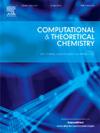Quantum chemical modeling of the unimolecular decomposition reactions of energetic Azine compounds
IF 3
3区 化学
Q3 CHEMISTRY, PHYSICAL
引用次数: 0
Abstract
A comprehensive initial decomposition mechanisms analysis of azine compounds was provided through quantum chemical modeling techniques, including the M06-2×-D3 method for optimization and CCSD(T)-F12/cc-pVDZ-F12 methods for energy calculations. Results showed that the number and position of nitrogen atoms in the ring significantly influence the decomposition reaction owing to the unique electron distribution. Compounds possessing two or more contiguous nitrogen atoms are prone to undergo direct ring-opening reactions, leading to the formation of N2, with tetrazine demonstrating the lowest Gibbs free energy of activation for this process. Conversely, molecules featuring an alternating arrangement of carbon and nitrogen atoms, such as pyrimidine and pyrazine, predominantly decompose to produce HCN. Functional groups such as nitro and amino enhance stability without altering the primary reaction pathway, while azide groups promote N2 release. These conclusions were expected to contribute significantly to the improved safety and application of novel high energy density materials.

含能Azine化合物单分子分解反应的量子化学模拟
通过量子化学建模技术,包括M06-2×-D3优化方法和CCSD(T)-F12/cc-pVDZ-F12能量计算方法,对氮类化合物进行了全面的初始分解机理分析。结果表明,环中氮原子的数目和位置由于其独特的电子分布对分解反应有显著影响。含有两个或更多相邻氮原子的化合物容易发生直接开环反应,导致N2的形成,四氮在这一过程中表现出最低的吉布斯自由活化能。相反,碳和氮原子交替排列的分子,如嘧啶和吡嗪,主要分解产生HCN。硝基和氨基等官能团在不改变主要反应途径的情况下增强了稳定性,叠氮化物基团促进了N2的释放。这些结论有望为提高新型高能量密度材料的安全性和应用做出重要贡献。
本文章由计算机程序翻译,如有差异,请以英文原文为准。
求助全文
约1分钟内获得全文
求助全文
来源期刊

Computational and Theoretical Chemistry
CHEMISTRY, PHYSICAL-
CiteScore
4.20
自引率
10.70%
发文量
331
审稿时长
31 days
期刊介绍:
Computational and Theoretical Chemistry publishes high quality, original reports of significance in computational and theoretical chemistry including those that deal with problems of structure, properties, energetics, weak interactions, reaction mechanisms, catalysis, and reaction rates involving atoms, molecules, clusters, surfaces, and bulk matter.
 求助内容:
求助内容: 应助结果提醒方式:
应助结果提醒方式:


